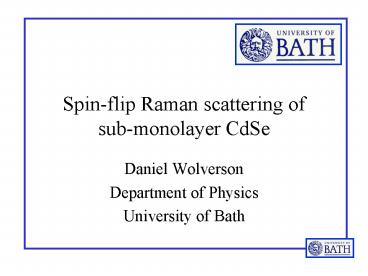Spin-flip Raman scattering of sub-monolayer CdSe - PowerPoint PPT Presentation
1 / 28
Title:
Spin-flip Raman scattering of sub-monolayer CdSe
Description:
U. Heriot-Watt. EPI Ltd. Sharp Ltd. Contents. Introduction to spin-flip Raman scattering ... Usually, the scattering (creation or annihilation) of light by ... – PowerPoint PPT presentation
Number of Views:82
Avg rating:3.0/5.0
Title: Spin-flip Raman scattering of sub-monolayer CdSe
1
Spin-flip Raman scattering ofsub-monolayer CdSe
- Daniel Wolverson
- Department of Physics
- University of Bath
2
Team and collaborators
- Oleg Karimov (CdSe)
- Ivan Griffin (AlGaInP)
- Catherine Orange (ZnSe)
- J. John Davies
- Stephen Bingham
- AF Ioffe Institute
- AN Reznitsky, AA Klochikin, SY Verbin, LN
Tenishev, SA Permogorov, SV Ivanov, EL Ivchenko - MPI-FKF Stuttgart
- T Ruf, M Cardona
- U. Bremen
- U. Wuerzburg
- U. Heriot-Watt
- EPI Ltd
- Sharp Ltd
3
Contents
- Introduction to spin-flip Raman scattering
- Zn1-xCdxSe epilayers
- CdSe fractional monolayers
- Related behaviour of other systems
4
Raman scattering
- Raman scattering is inelastic light scattering
- Usually, the scattering (creation or
annihilation) of light by phonons is implied - The processes illustrated on the left are
resonant their cross-section is very large when
the excitation energy equals an excitonic
transition energy
5
PL of cubic Zn1-xCdxSe
6
SFRS of Zn1-xCdxSe
7
Measured electron g-factorsfor Zn1-xCdxSe
8
kp model and parameters
9
Calculation of ge for Zn1-xCdxSe
10
CdSe fractional monolayers
- Large lattice mismatch between CdSe, ZnSe
- CdSe cubic on ZnSe (normally wurtzite)
- Self-organised dots form at around 3 monolayers
- Growth of 0.5 ML of CdSe on ZnSe gives islands
probably of Zn1-xCdxSe - Transition energies close to those of ZnSe
- Exciton localised at island rather than confined
11
M Strassburg et al., APL 72 (1998) 942
12
Photoluminescence of CdSe FMs
- Large blue shift compared to CdSe
- Large lh-hh splitting of around 30meV
- Broad PL band with long low-energy tail
- Stokes shift of PL band of around 10meV from hh
13
SFRS of CdSe FMs
- Stokes and anti-Stokes signals present
- Faraday geometry
- Selection rules obeyed
- Excitation in resonance with PL band shown
previously
14
Varying the direction of B
- Several new signals appear
- Raman shifts vary with angle B, z
- Anisotropy suggests valence band states are
involved and thus excitonic levels
15
B in-plane
- Faraday geometry
- Two Raman signals
- Signal DE depends on excitation photon energy
- Signal DE shows both Stokes and anti-Stokes
lines.
16
Resonance behaviour ofFM signals
- solid line PL
- triangles PLE
- open circles E
- solid circles DE
17
Varying the magnitude of B
- DE signal not linearly dependent on magnetic
field - Non-zero splitting d0 at zero magnetic field
- Splitting d0 is a function of excitation photon
energy
18
Excitons localised at CdSe FMs
- Should consider effects of
- strain and confinement
- electron and hole Zeeman splitting (linear in B,
J) - electron-hole exchange (linear in J)
- crystal field, terms cubic in J, higher powers of
B - PL shows that 1. is required
- B field dependence shows that 2. and 3. are
required 3. gives splitting at zero field - No evidence for need for 4.
19
Simplest model
- neglect terms in J3
- electron gc isotropic
20
Exciton spin and zero-field splittings
In zincblende Td symmetry
- Optical emission from the exciton spin state F2
is forbidden, hence dark exciton, DE. - Electron-hole exchange splits the F1 (G5) and
F2 (G3,G4) states (even at zero magnetic field). - Strain splits the lh and hh components of these.
- Crystal field could also split G3 and G4.
21
Comparison of model and data
- 4 hh energy levels (given the large lh-hh
splitting) two F2 (DE), two F1 - At least 4 of 6 possible transitions are observed
- These are described by the model with one set of
parameters for all angles between B, z and all
values of B.
22
Exchange and localisation
- Large exchange energy compared to bulk binary
materials (around 10) - Linear variation of exchange splitting with
localisation energy - SFRS studies of alloys show similar effects
23
Alloy SFRS
- p-type doped (Ga,In)P alloys show signals
identified as electron (e) and hole (h) SFRS. - Hole signal becomes anisotropic when a biaxial
strain is applied. - Calculated electron g-factor (3-band kp) agrees
well with experiment.
24
Resonance of SFRS signals
- High-energy side of high-energy PL band
- Similar for electron and hole but hole at
slightly lower energy - No signals observed with excitation at low-energy
PL band
25
Effects of increasing Al content
- Increasing Al content increases disorder and,
therefore, potential fluctuations - New signals develop (in addition to electron and
hole-like signals) - New signals show zero-field splittings
26
Exciton localisation in alloys
- (Al,Ga)0.5In0.5P and also (Zn,Mg)(S,Se) alloys
studied by SFRS - Electron and hole signals identified in doped
layers - Exciton signals seen in undoped layers
- Exchange splitting present
- Exchange again correlated with excitation energy
27
Differences between alloys FMs
- For (Al,Ga)0.5In0.5P
- Lattice-matched to substrate, therefore very
small (or zero) strain - Must include lh and hh.
- Potential fluctuations are due only to alloy
disorder - Exciton radius is larger than in the II-VI
selenides - Exchange splitting smaller
28
Summary
- Spin-flip Raman scattering is a versatile
technique for the investigation of excitonic fine
structure - Excitonic localisation occurs in a wide variety
of systems and leads to similar SFRS spectra
(III-V and II-VI alloys and FM structures) - Fractional monolayer structures are model systems
for the study of exciton localisation with the
useful features of (i) a large lh-hh splitting
and (ii) a significantly enhanced exchange energy





















![Top 5 Tennis Strings for Spin 2021 [Reviewed] PowerPoint PPT Presentation](https://s3.amazonaws.com/images.powershow.com/9683536.th0.jpg?_=202111150212)









